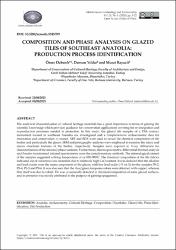Composition and Phase Analysis on Glazed Tiles of Southeast Anatolia: Production Process Identification
Künye
DABANLI, Ömer, Dursun YILDIZ & Murat Bayazıt. "Composition and Phase Analysis on Glazed Tiles of Southeast Anatolia: Production Process Identification". Mediterranean Archaeology and Archaeometry, 21.3 (2021): 1-22.Özet
The analytical characterization of cultural heritage materials has a great importance in terms of gaining the scientific knowledge which provides guidance for conservation applications covering the re-integration and re-production processes needed in protection. In this study, the glazed tile samples of a 15th century monument located in southeast Anatolia are investigated and a comprehensive archaeometric data for restoration and conservation is created. XRF and EDX were used to reveal the chemical composition of tile bodies and particularly the glazes. SEM and petrography analyses were employed to examine the micro and macro structural features of the bodies, respectively. Samples were exposed to X-ray diffraction for characterization of the mineral/phase contents. Furthermore, thermogravimetric differential thermal analysis and Fourier transformed infrared spectrometry were the complementary methods. The mineralogical content of the samples suggested a firing temperature of ca 850-900oC. The chemical composition of the tile fabrics indicated use of calcareous raw materials due to relatively high CaO content. It was deduced that the alkaline and lead oxides were the main components of the glazes, with low lead oxide (˂5 wt.%) for the samples PS-2, PS-4, PS-5 and PS-6. It was also seen that the blue/green turquoise colors were obtained with copper, whereas blue itself was due to cobalt. Tin was occasionally detected in chemical composition of some glazed surfaces, and its presence was mostly attributed to the purpose of gaining opaqueness.



















